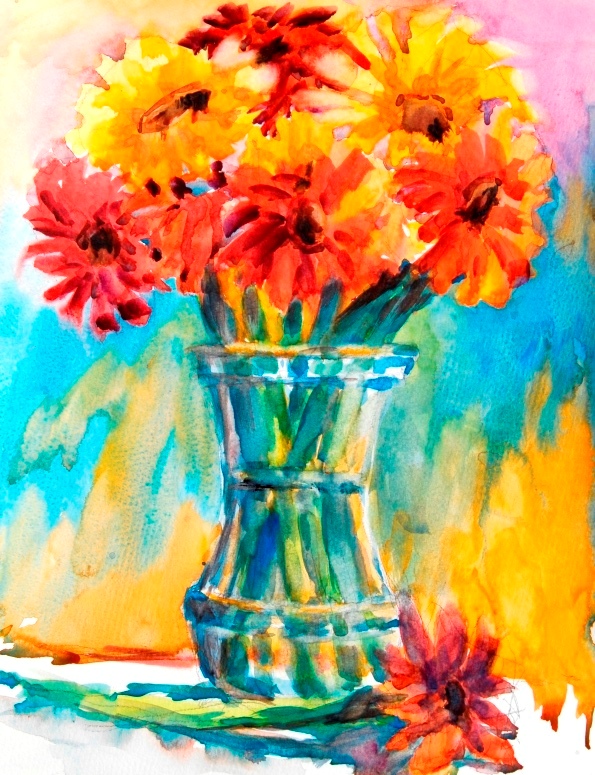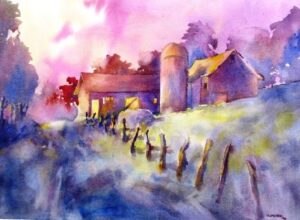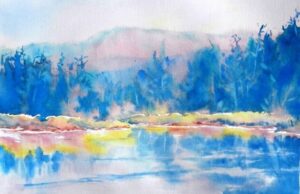Interested in an Original Painting?
Contact Virgil to inquire.
Interested in fine art prints and
more? Shop Fine Art America

“Flowers, No. 7”, Watercolor, 11” X 15”
![]() 10 April 2025
10 April 2025
Welcome back! In this blog we are exploring ideas and experiences to help those who love art, collect art and make art, especially in watercolor.
Watercolor painting, with its luminous washes and delicate blooms of color, often evokes a sense of ethereal beauty and effortless creation. However, for those unfamiliar with the medium, it can also seem mysterious and perhaps even intimidating. Experienced watercolor painters understand just how much knowledge and skill it takes to consistently make successful paintings.
This article aims to demystify watercolor, offering insights into its unique characteristics and techniques in a way that builds understanding and appreciation for laypersons.
Imagine working with pure pigment suspended in water. This is the essence of watercolor. Unlike opaque paints like acrylics or oils that cover the surface, watercolor relies on the transparency of its pigments. The white of the paper itself becomes an active participant in the artwork, reflecting light back through the thin layers of color, creating a characteristic luminosity that is difficult to achieve with other mediums. This inherent transparency is both a strength and a challenge. Mistakes are less easily covered, demanding a more thoughtful and often more fluid approach to painting.
One of the fundamental concepts to grasp is the relationship between water and pigment. The amount of water used dictates the intensity and flow of the paint. More water creates lighter, more transparent washes that spread easily across the paper, ideal for skies, atmospheric effects, and delicate details. Less water results in richer, more concentrated color that offers greater control for defining shapes and adding bolder accents. This dance between water and pigment is central to watercolor’s unique expressive capabilities. Think of it like diluting a fruit juice – more water weakens the flavor and makes it more fluid, while less water intensifies the taste and makes it thicker.


The paper plays a crucial role in watercolor painting. Unlike regular drawing paper, watercolor paper is specifically designed to withstand the application of water without buckling or falling apart. It comes in various textures (hot-pressed, cold-pressed, and rough) and weights (measured in pounds or grams per square meter). Hot-pressed paper is smooth, ideal for fine details. Cold-pressed paper has a slight texture, offering a good balance for various techniques. Rough paper has a pronounced texture, creating interesting granular effects. Understanding the different paper types helps artists control how the paint behaves and achieve desired textures. Imagine painting on a smooth versus a slightly bumpy surface – the paint will interact differently with each.
Watercolor techniques often involve layering washes of color, a process known as glazing. Because the paint is transparent, each subsequent layer interacts with the colors underneath, creating depth and complexity. For example, applying a thin wash of blue over a dry wash of yellow will result in a subtle green. This layering approach allows for nuanced color mixing directly on the paper, contributing to the vibrancy and depth of the final artwork. Think of it like looking through colored cellophane sheets stacked on top of each other – each layer contributes to the final color you see.
Another key technique is working wet-on-wet. This involves applying wet paint onto wet paper. The colors blend and bleed together in unpredictable yet often beautiful ways, creating soft edges and atmospheric effects. This technique is often used for backgrounds, skies, and flowing water. In contrast, wet-on-dry involves applying wet paint onto dry paper, resulting in sharper edges and greater control over detail. Artists often combine these techniques within a single painting to achieve a range of effects. Imagine dropping colored ink onto a damp sponge versus a dry piece of paper – the ink will spread and blend differently in each case.
Understanding the concept of resisting is also important. Because watercolor flows with water, artists can use various materials to prevent paint from adhering to certain areas. Masking fluid, a liquid latex, can be applied to preserve white areas or create sharp edges. Wax crayons or candles can also resist water-based paints. This allows for intricate details and negative painting, where the surrounding areas are painted, leaving the unpainted paper to define the subject. Think of drawing with a crayon on paper and then painting over it with water – the paint will bead up and not adhere to the waxy lines.
Finally, it’s crucial to appreciate the unpredictability inherent in watercolor. While techniques offer a degree of control, the interaction of water, pigment, and paper often results in unexpected and delightful surprises. Blooms, where wet paint pushes outwards as it dries, and granulation, where pigments settle unevenly creating a textured effect, are just two examples of these unique characteristics. Embracing this element of chance is part of the beauty of working with watercolor. It’s less about rigid control and more about guiding the flow and allowing the medium to express itself.
In conclusion, watercolor painting is a captivating art form that relies on the delicate interplay of water, pigment, and paper. Understanding the principles of transparency, layering, wet-on-wet and wet-on-dry techniques, and the concept of resisting paint provides a foundational understanding for appreciating its unique qualities. While it may seem challenging at first, the luminous beauty and expressive potential of watercolor make it a rewarding medium for both artists and observers alike. It’s an invitation to witness the magic that unfolds when color meets water on paper.
So, do you agree or disagree? What are your insights on painting with watercolor? Share with me. And sling paint!
Contact Virgil to inquire.
more? Shop Fine Art America

“You Must Go Left or Right” , Watercolor, 30” X 11”